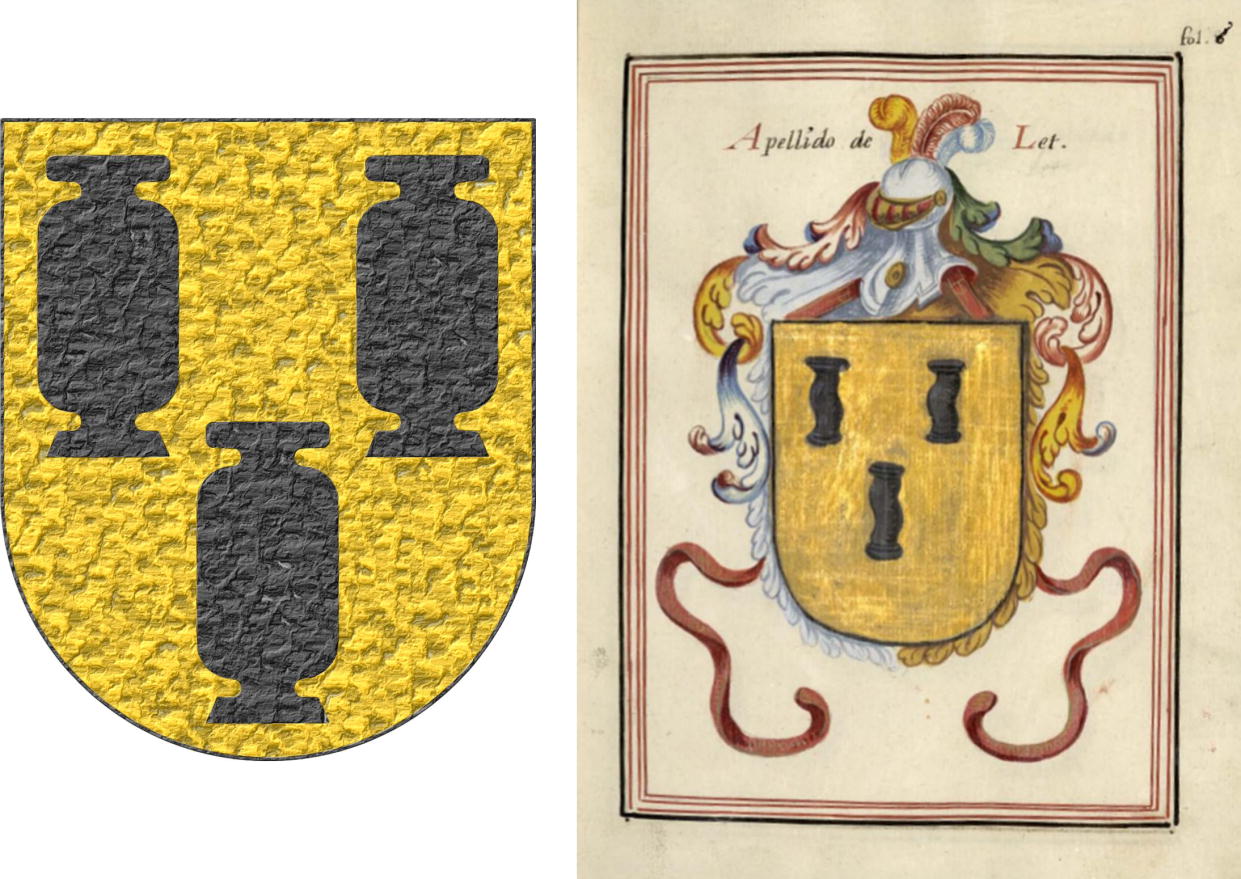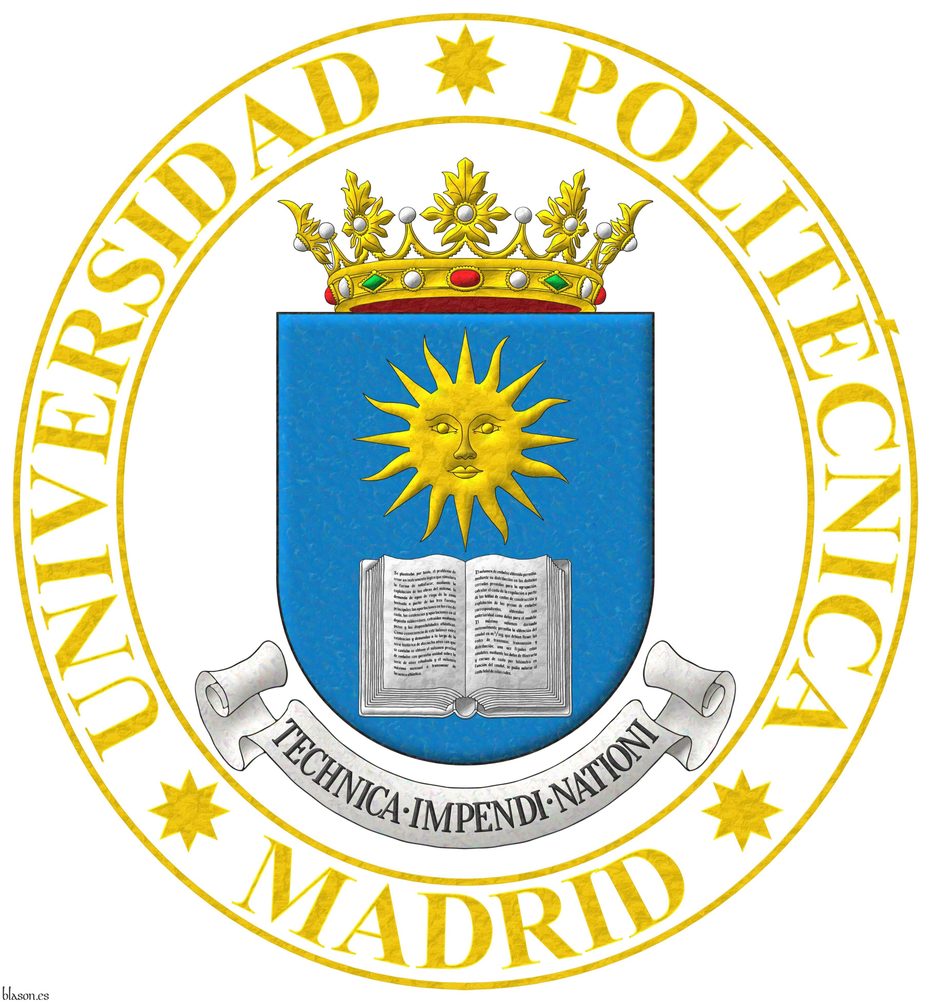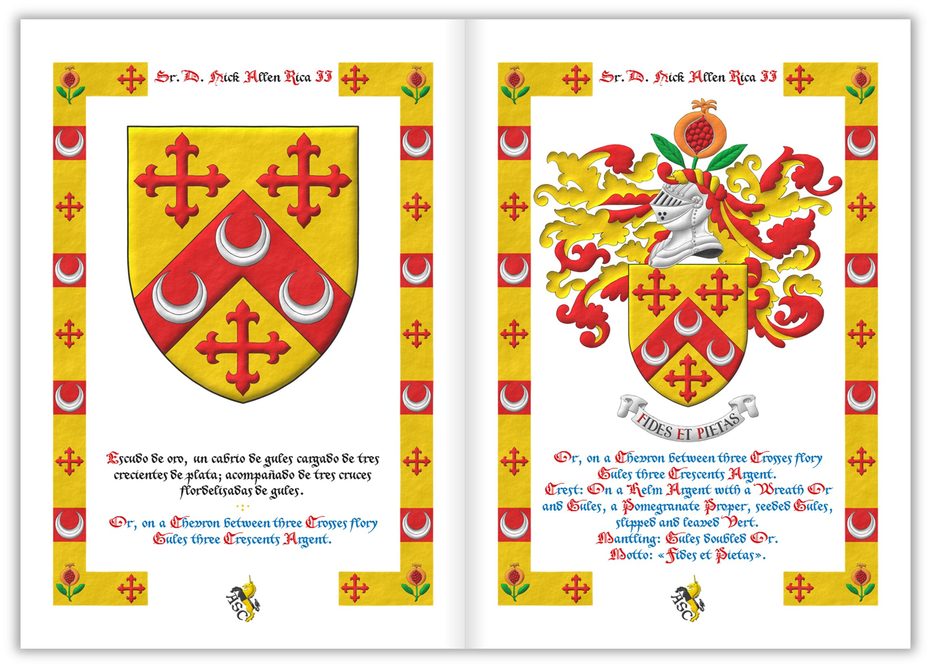
![Ver [Menéndez Pidal de Navascués, F.; Martínez de Aguirre, J.; 2000] en referencias bibliográficas. Libro abierto, hojas de plata, filo de oro, guardas de gules, tapas de sable.](../css/Libro.Bibliografia.png)
Menéndez Pidal de Navascués, F.; Martínez de Aguirre, J.; 2000
Faustino Menéndez Pidal de Navascués and Javier Martínez de Aguirre Aldaz, «The Coat of Arms of Navarra», published by the Government of Navarra, Department of Presidency, Justice, and Interior, ISBN 84-235-2016-1, 115 pages, Pamplona, 2000.
This is one of the many publications by Faustino Menéndez Pidal de Navascués on the Navarrese armorial [Bosque, J. del; 1540]. Later, 7 years after, Javier Martínez de Aguirre Aldaz, co-author of this book, would publish an interesting article, [Martínez de Aguirre, J.; 2007], about Faustino Menéndez Pidal de Navascués as a researcher of Navarrese heraldry.
Bibliographical reference of century XX.
The 2 authors are Menéndez Pidal de Navascués, Faustino and Martínez de Aguirre Aldaz, Javier.
Bibliographic reference mentioned in the following articles:
External resource:


![Ver [Urfe; Century XV] en referencias bibliográficas. Libro abierto, hojas de plata, filo de oro, guardas de gules, tapas de sable.](../css/Libro.Bibliografia.png)
Urfe; Century XV
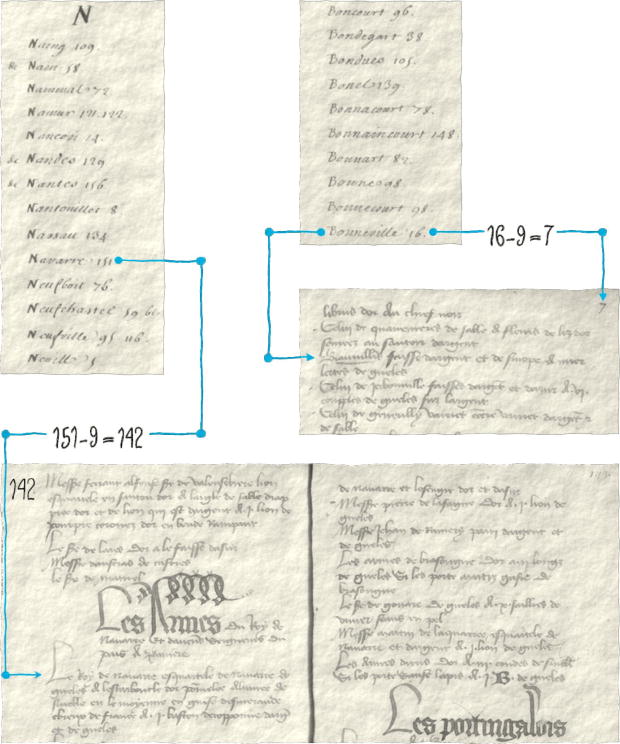
Urfé, unknown authors, «Urfe's Armorial», is currently in National Library of France (BnF, Bibliothèque nationale de France), in Paris, «Cabinet des titres» 927 as indicated on page I, cataloged with the code ms. fr. 32753, it is estimated from the XV century.
This armorial is written in French, on parchment measuring 19.5 x 14 centimeters, its compilation is believed to have been done in the 15th century, it presents 2,855 blazons in written form, but without illustrations, its blazons are organized into 54 sections, with an average of 17 blazons per page, the densest pages with about 20 blazons of 1, 2, or 3 lines per blazon, although some are longer. This Urfé armorial has served as a source for later armorials.
This manuscript contains a preliminary index, written later, of 61 pages, foliated the odd pages in consecutive Roman numerals from folio I to folio XXX. That is, 30 folios of 2 pages plus a final page, totaling 30 x 2 + 1 = 61 pages. This preliminary index consists of a name and a page number where the «theoretically», as will be explained below, corresponding blazon appears.
Next comes the true body of the Urfé armorial, of 162 pages, foliated only the odd pages, dated later than the compilation of the manuscript, in Arabic numerals, 2 by 2, from folio 1 to 161. That is, 1, 3, 5, 7, ..., 159, 161, and the last existing unnumbered page, as it is the 162nd which is even. I say that the 162nd is the last existing page because the National Library of France classifies it as an incomplete manuscript at the end.
It is a bit difficult to understand the relationship between the numbers that appear in the preliminary index, accompanying the names, and the numbering of the pages of the Urfé armorial. For example:
- Bouneville, which in the index appears with the number 16, is blazoned on page 7 (16 - 9 = 7).
- Navarre, for Navarra, in the index appears with the number 151, while the blazon of "Le Roy de Navarre" appears on page 142 (151 - 9 = 142).
This rule of subtracting 9, which has worked for me, but may not be of general use as, for example, Castille~Castile, on page VIII of the index, refers to page 140 of the content and it is there where it is actually found.
The Urfé armorial is in the public domain and the National Library of France, since February 23, 2012, has it published online with identification key ark:/12148/btv1b9063217v.
In this online version, as of today and until corrected, I believe that after page XIX, XVIII and XIX are repeated, just as folio 5 is repeated twice.
Bibliographical reference of century XV.
Classification: Armorial roll, Manuscript, In black and white and French language.
Author: unknown.
Bibliographical reference mentioned in the following article:
External resources:
- Urfe in Gallica BnF.
- Bouneville indexed in the page 16.
- although it is really on the page 7 (16-9=7).
- Navarra indexed in the page 151.
- although it is really on the page 142 (151-9=142).
- Castilla indexed in the page 140.
- is effectively, in this case, on the same page 140.


![Ver [Vega, P. J. de; 1702] en referencias bibliográficas. Libro abierto, hojas de plata, filo de oro, guardas de gules, tapas de sable.](../css/Libro.Bibliografia.png)
Vega, P. J. de; 1702
Pedro José de Vega, «Compendio de la Maior Parte Ð los Blassones, Armas, e Ynsignias Ð las Ylustres Casas, Familias, y Apellidos del Reyno Ð Navarra i Parte Ð la Provincia de Gvipvzcoa, Segvn las Vsan y Traen los Svccesores Ðellas» ~ «Compendium of the Greater Part of the Blazons, Arms, and Insignias of the Illustrious Houses, Families, and Surnames of the Kingdom of Navarre and Part of the Province of Guipuzcoa, As Used and Carried by Their Successors», manuscript in 2 volumes, Volume I, catalog number MSS/7835 V.1, and Volume II, catalog number MSS/7836 V.2, in the National Library of Spain, 1702.
As stated on the title page, the Field Master «Pedro Ioseph Ð Vega» was a native of the Kingdom of Navarre, deputy of the Kingdom of Navarre from 1688 to 1691, governor of the provinces of Cotabamba and Parinacochas in Peru, written as «governador», and gentleman of the «Voca de su Majestad» (His Majesty's Voice).
Bibliographical reference of century XVIII.
The author is Vega, Pedro José de.
Here are the articles quoting this reference:
- Almorrabides of Navarre
- Aybar of Navarre
- Baztanes of Navarre
- Guebara of Navarre
- Lete of Navarre
- Mauleón of Navarre
- Monteagudo of Navarra
- Navarra, emerald overall
- Qasqante of Navarre
- Rada of Navarre
- Subiça of Navarre
- Urroz of Navarre
- Vidaurre of Navarre
External resource:


Technical University of Madrid
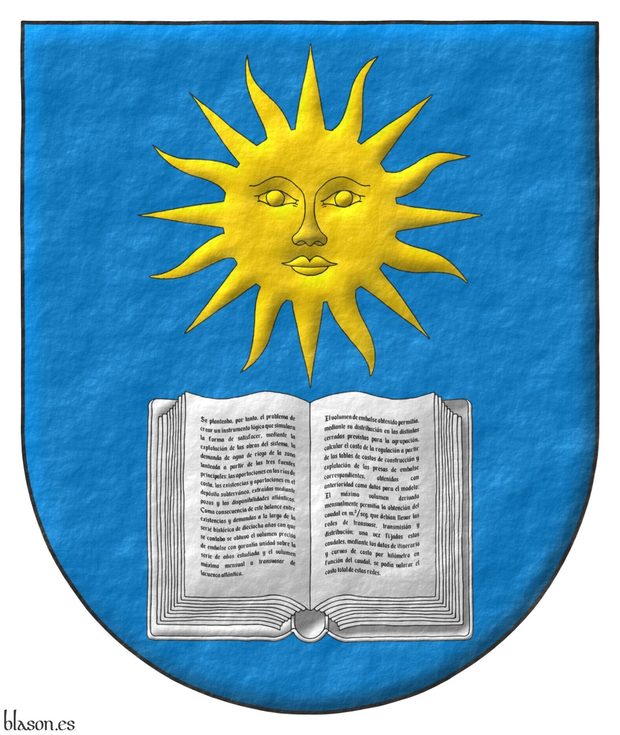
UPM
Azure, in base an open book Argent, in chief a sun in splendour Or.
Escudo de azur, un libro abierto de plata surmontado de un sol de oro.
Coat of arms interpreted with the following features: the base is semicircular (round); the field and charges are illuminated in the tinctures Azure and the metals Argent and Or, all outlined in Sable; unlike other variants the sun’s rays are not black sino de oro y el texto politécnico del libro es legible; y the whole finished with a rough-paper texture.
For my interpretation of this coat of arms, the text I have chosen to write on the pages of the open book is taken from [Cuena Bartolomé, J.; 1968; page 417, section 2, paragraphs 2o, 3o y 4o], which begins with the phrase «Se planteaba», a phrase very characteristic of José Cuena Bartolomé.
He elegido estos paragraphs porque son de José Cuena, 1937-1999, Professor of Computer Science and Artificial Intelligence at the Technical University of Madrid (UPM), who was my teacher and PhD supervisor, because in them are combined hydraulics, the use of the computer, mathematical simulation models, economic cost considerations, data in the form of time series, the underground, the oceanic, irrigation,... and, therefore, they combine various branches of engineering and study topics from many of them, such as civil engineering, computer engineering, agricultural engineering,... Additionally, as this text is almost half a century old, it is technically historical, no longer at risk of obsolescence, a risk that more recent texts would indeed have.
Blazon keywords: Without divisions, Azure, Argent, Or, Book and Sun in splendour.
Style keywords: Semi-circular, Illuminated, Outlined in sable and Rough.
Classification: Interpreted, Socioeconomic and Education.
Bearer: Technical University of Madrid.


UPM
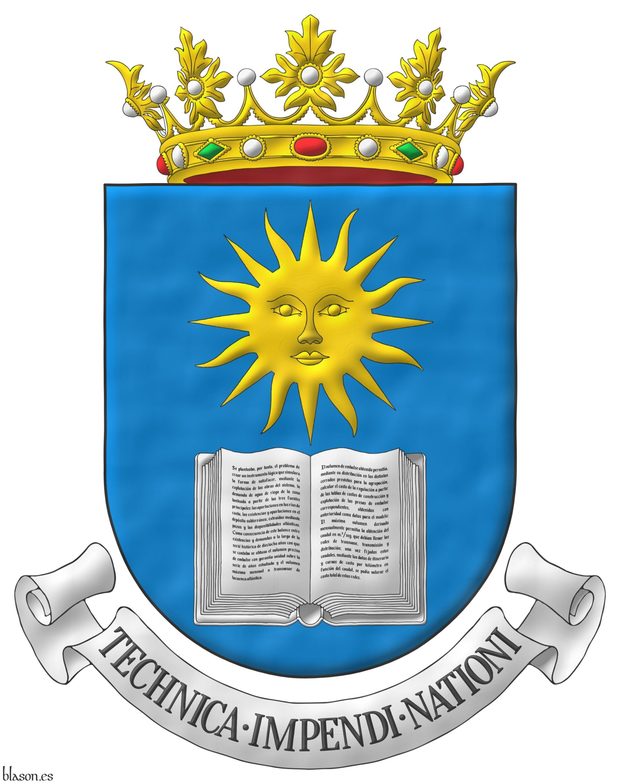
Universidad de Politécnica de Madrid
Azure, in base an open book Argent, in chief a sun in splendour Or. Crest: An open royal crown. Motto: «Technica impendi nationi».
Escudo de azur, un libro abierto de plata surmontado de un sol de oro. Timbrado de una corona real abierta. Lema: «Technica impendi nationi».
Coat of arms interpreted with: a semicircular (round) base; the field and charges are illuminated in the tinctures Azure and the metals Argent and Or, all outlined in Sable; it differs from other versions of this coat of arms in that the rays of the sun are Or instead of black, that the text over the two pages of the book can be read, and also that the three words of the motto are separated by a small dot; and the whole is watercolored.
UPM was founded in 1971 with the integration of the Higher Technical Schools of the Higher Polytechnic Institute to which the University Schools were added in 1972. It is the first university where I studied and the one from which I have the honor of holding a doctorate.
Blazon keywords: Without divisions, Azure, Argent, Or, Book, Sun in splendour, Crest and mantling, Crown, Open royal crown and Motto.
Style keywords: Semi-circular, Illuminated, Outlined in sable and Watercolor.
Classification: Interpreted, Socioeconomic and Education.
Bearer: Technical University of Madrid.


Technica impendi nationi
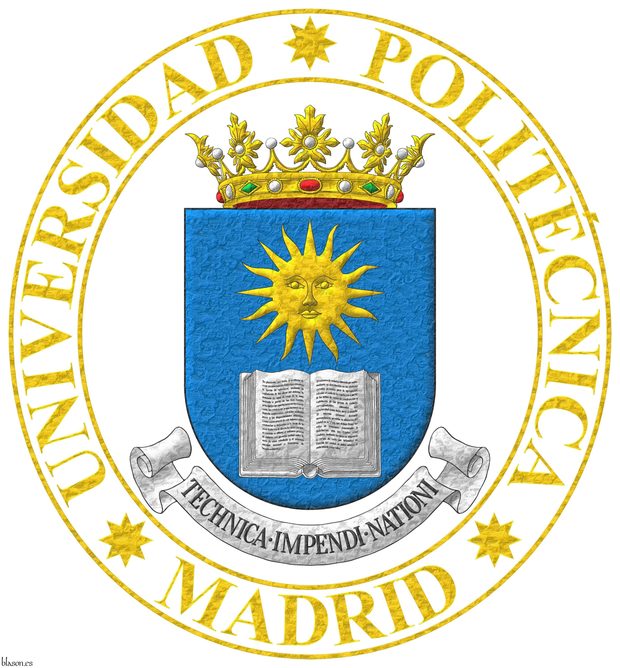
Azure, in base an open book Argent, in chief a sun in splendour Or. Crest: An open royal crown. Motto: «Technica impendi nationi». Motto around the shield: «Universidad de Politécnica de Madrid» fimbriated and depinted Or.
Escudo de azur, un libro abierto de plata surmontado de un sol de oro. Timbrado de una corona real abierta. Lema: «Technica impendi nationi». Divisa alrededor del escudo: «Universidad de Politécnica de Madrid» perfilada y en letras de oro.
Coat of arms interpreted as follows: a semicircular (round) base; the field in flat Azure; the field and charges are illuminated in the tinctures Azure and the metals Argent and Or, all outlined in Sable; my rendition of this coat of arms differs from others in that the sun’s rays, although outlined in Sable, are Or; in the legibility of the text written on the book; and in separating with a dot the words that form the motto; and the whole finished with a beaten-metal effect.
Metal batido y anacarado
Blazon keywords: Without divisions, Azure, Argent, Or, Book, Sun in splendour, Crest and mantling, Crown, Open royal crown, Motto and Motto (identification).
Style keywords: Semi-circular, Oval, Illuminated, Outlined in sable and Metal beaten.
Classification: Interpreted, Socioeconomic and Education.
Bearer: Technical University of Madrid.


Completion and fulfillment, a phase with three activities
Heraldic edition:
- Its objective is the definitive edition of the blazon and its explanatory texts illustrated with images of the coat of arms, accompanied by the heraldic objects that complement it and adorned with a specific framework tailored to each registrant.
- Its outcome is a catalog of delivery of the heraldic work stamped, signed, dated and numbered.
Final review and delivery:
- Its goal is a last review of the complete work and to perform the latest appropriate corrections.
- The result is the delivery of the work to its holder, point where the heraldic process end.
Documentation and closure of records:
- Its goal is to finish the internal documentation of the work and the final archival of both the intermediate material and the final result.
- The result is a new record, keyed on the numbering of the heraldic catalog, in a documentary and graphic content management file.


![Ver [Cuena Bartolomé, J.; 1968] en referencias bibliográficas. Libro abierto, hojas de plata, filo de oro, guardas de gules, tapas de sable.](../css/Libro.Bibliografia.png)
Cuena Bartolomé, J.; 1968
José Cuena Bartolomé, Doctor of Civil Engineering (Roads, Canals and Harbours) of the Computing Office of the Center for Studies and Experimentation of Public Works, «The ordered trial of solutions in hydraulic systems by means of mathematical simulation models on an electronic computer» Journal of «Obras Públicas» del College of Roads, Canals and Harbours, 115, volume I, number 3038, pages 413-430, ISSN 0034-8619, ISSN electronic 1695-4408, Legal Deposit M-156-1958, Madrid, June 1968.
Bibliographical reference of century XX.
Classification: Magazine and Castilian language.
Author: José Cuena Bartolomé.
The following article cites this bibliographic reference:

Continue with: Registro Internacional de Armas Gentilicias.
-
Language
-
Categories of heraldry
-
Divisions of the field
- Without divisions
- Party per pale
- Party per fess
- Party per bend
- Party per bend sinister
- Tierce
- Tierce sinister
- Tierced per pale
- Tierced per fess
- Tierced per bend
- Tierced pallwise inverted
- Quarterly
- Quarterly per saltire
- Gyronny
- Party per fess, the chief per pale
- Party per pale, the sinister per fess
- Party per fess, the base per pale
- Party per pale, the dexter per fess
- Chapé
- Chaussé
- Embrassé
- Contre-embrassé
- Party per chevron
- Enté
- Enté en point
- Flanched
-
Metals
-
Colours
-
Furs
-
Other tinctures
-
Ordinaries and sub-ordinaries
-
Diminutives of the ordinaries
-
Geometric charges
-
Composite ordinaries
-
Inanimate charges from Nature
Atom, Crescent, Diamond, Emerald, Estoile, Increscent, Lightning flash, Moon, Mount, Mullet, Mullet of four points, Orbital, Plough of Ursa Major, Rainbow, Ray of the sun, River, Sea, Snowflake, Sun, Sun in splendour, Sun of May, Trimount, Water and Wave.
-
Vegetal charges from Nature
Acorn, Apple, Apple tree, Ash, Bluebonnet, Camellia, Chrysanthemum, Cinquefoil, Cornflower, Dogwood flower, Double rose, Elm, Fleur de lis, Flower, Gourd, Holm oak, Hop cone, Kapok tree, Laurel, Lily, Linden, Lotus flower, Madonna lily, Mexican cedar tree, Oak, Olive tree, Palm tree, Plantain plant, Pomegranate, Poplar leaf, Rose, Shamrock, Sunflower, Thistle, Tree, Tulip, Vine and Wheat.
-
Animal charges from Nature
Badger, Bald eagle, Barbel, Barn owl, Bear, Beaver, Beetle, Bighorn sheep, Blackbird, Boar, Brach hound, Bull, Doe, Dog, Dolphin, Dove, Eagle, Elephant, Falcon, Female figure, Fish, Flame, Fly, Fox, Frog, Goat, Goldfinch, Goose, Heron, Horse, Hummingbird, Jaguar, Lark, Leopard, Lion, Lion passant, Lion rampant guardant, Lioness, Lynx, Male figure, Martlet, Merino ram, Owl, Panther, Parrot, Peacock, Pelican, Pelican in her piety, Puffin, Quetzal, Raven, Roe deer, Rooster, Savage, Seagull, Serpent, She-wolf, Stag, Starling, Talbot, Tyger, Vulture, Warren hound and Wolf.
-
Parts of natural charges
Arm, Beak, Branch, Caboshed, Chest, Claw, Covert, Dorsal fin, Eagle claw, Ermine spot, Escallop, Feather, Foot (palmiped), Foreleg, Forepaw, Hand, Head, Heart, Hoof, Leaf, Neck, Ostrich feather, Palm frond, Paw, Roe deers' attires, Shoulder, Sprig, Stags' attires, Stem, Swallow-tail, Tail, Tail addorsed, Tail fin, Talon, Tooth, Trunk, Trunk (elephant), Two hands clasped, Two wings in vol, Udder, Wheat spike, Wing and Wrist.
-
Artificial charges
Ace of spades, Anchor, Anvil, Arch, Arm vambraced, Armillary sphere, Arrow, Axe, Bell, Bell tower, Beret, Bonfire, Book, Bookmark, Bow, Branding iron, Bridge, Broken, Buckle, Cannon, Cannon dismounted, Cannon port, Canopy roof, Carbuncle, Castle, Celtic Trinity knot, Chain, Chess rooks, Church, Clarion, Clay pot, Closed book, Club, Column, Comb, Compass rose, Conductor's baton, Cord, Covered cup, Crozier, Crucible, Cuffed, Cup, Cyclamor, Dagger, Double vajra, Drum, Ecclesiastical cap, Fanon, Federschwert, Fleam, Four crescents joined millsailwise, Galician granary, Garb, Gauntlet, Geometric solid, Grenade, Halberd, Hammer, Harp, Host, Hourglass, Key, Key ward, Knight, Knot, Lantern, Letter, Line, Loincloth, Menorah, Millrind, Millstone, Millwheel, Monstrance, Mortar, Mullet of six points pierced, Nail, Non-classic artifact, Norman ship, Number, Oar, Oil lamp, Open book, Page, Pair of scales, Parchment, Pestle, Piano, Pilgrim's staff, Plough share, Polish winged hussar, Port, Portcullis, Potent, Quill, Ribbon, Rosette of acanthus leaves, Sabre, Sackbut, Sail, Scroll, Scythe, Sheaf of tobacco, Ship, Skirt, Spear, Spear's head, Stairway, Star of David, Step, Sword, Symbol, Tetrahedron, Torch, Tower, Trident, Trumpet, Turret, Two-handed sword, Wagon-wheel, Water-bouget, Wheel, Winnowing fan and With a turret.
-
Immaterial charges
Angel, Archangel, Basilisk, Dragon, Dragon's head, Garuda, Golden fleece, Griffin, Heart enflamed, Justice, Mermaid, Our Lady of Mercy, Ouroboros, Paschal lamb, Pegasus, Phoenix, Sacred Heart of Jesus, Saint George, Sea-griffin, Trinity, Triton, Unicorn, Winged hand and Wyvern.
-
External elements
-
Heraldic creations
-
References
-
Formats
-
Keywords on this page
Watercolor, Armorial roll, Artist, Azure, Bibliography, Cantoned, Crown, Open royal crown, Outlined in sable, Outlined in the field tincture, Motto (identification), Education, Elephant, In black and white, Diminished cross, Mullet, Gules, Illuminated, Institution, Interpreted, Chief, Motto, Castilian language, French language, Book, Manuscript, Semi-circular, Metal beaten, Eight, Or, Oval, Canting, Passant, Patty, Argent, Without divisions, Clay pot, Registro Internacional de Armas Gentilicias, Kingdom of Navarre, Magazine, Rough, Sable, Century XV, Century XVIII, Century XX, Socioeconomic, Sun in splendour, Technical University of Madrid and Crest and mantling.

